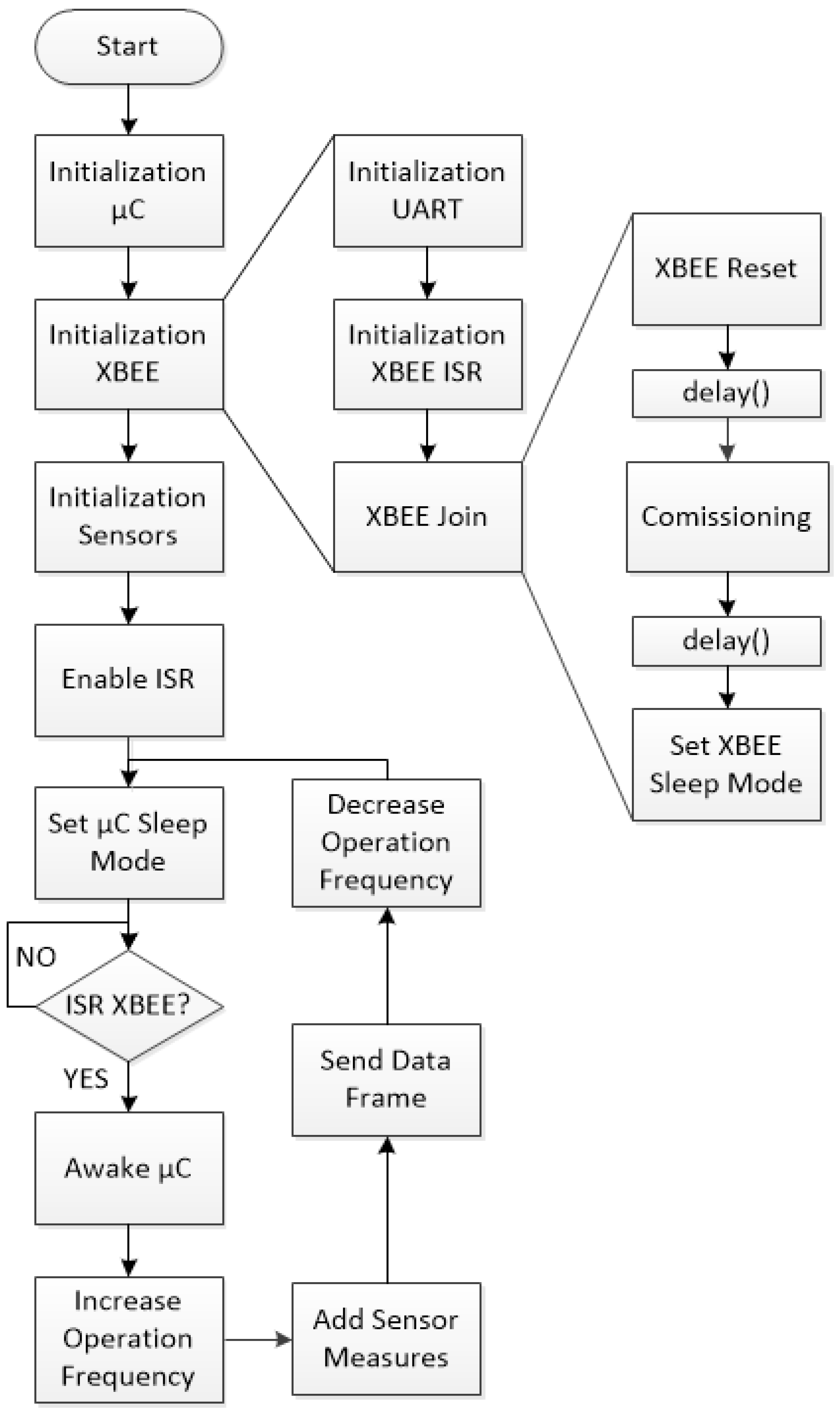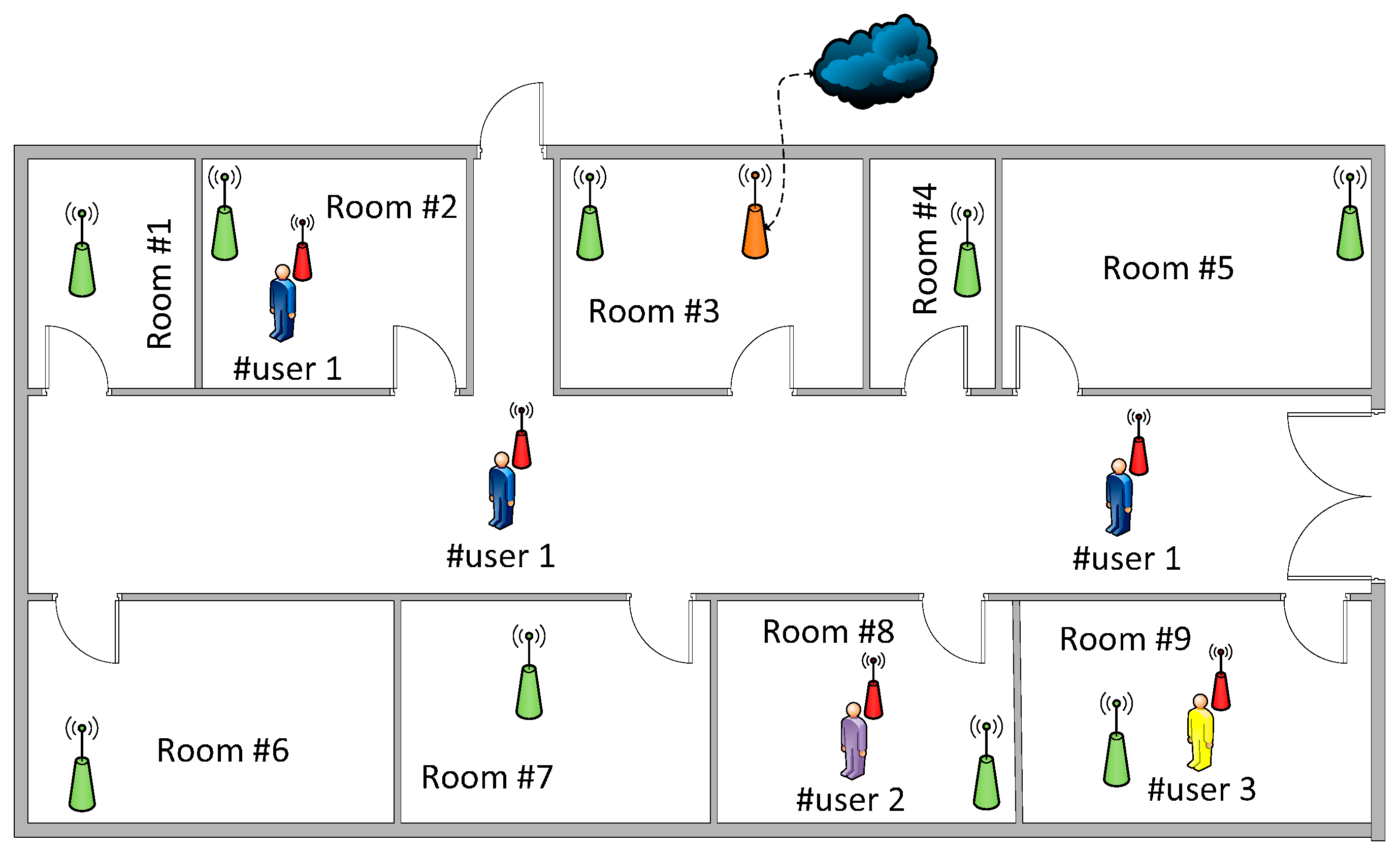A Wearable Wireless Sensor Network for Indoor Smart Environment Monitoring in Safety Applications
Abstract
:1. Introduction
2. Previous Work
3. Wearable Wireless Node Architecture
3.1. Wearable Sensor Node Hardware Design
3.2. Wearable Sensor Node Software
4. Network Test
5. Web Data Collection and Processing
6. Conclusions
Acknowledgments
Author Contributions
Conflicts of Interest
References
- Lee, E.A.; Seshia, S.A. Introduction to Embedded Systems, A Cyber-Physical Systems Approach, 2nd ed.; MIT Press: Cambridge, MA, USA, 2017. [Google Scholar]
- Marwedel, P. Embedded System Design. Embedded Systems Foundations of Cyber-Physical Systems, 2nd ed.; Springer: Dordrecht, The Netherlands, 2011. [Google Scholar]
- Wang, H.; Liu, J.; Han, J. RS-CPS: A distributed architecture of robotic surveillance cyber-physical system in the nature environment. In Proceedings of the IEEE International Conference on Cyber Technology in Automation, Control, and Intelligent Systems (CYBER), Shenyang, China, 8–12 June 2015; pp. 1287–1292.
- Paul, S.; Parajuli, A.; Barzegaran, M.R.; Rahman, A. Cyber physical renewable energy microgrid: A novel approach to make the power system reliable, resilient and secure. In Proceedings of the IEEE Innovative Smart Grid Technologies-Asia (ISGT-Asia), Melbourne, Australia, 28 November–1 December 2016; pp. 659–664.
- Wu, W.; Aziz, M.K.; Huang, H.; Yu, H.; Gooi, H.B. A real-time cyber-physical energy management system for smart houses. In Proceedings of the IEEE PES Innovative Smart Grid Technologies, Perth, WA, USA, 13–16 November 2011; pp. 1–8.
- Pang, C.; Vyatkin, V.; Mayer, H. Towards cyber-physical approach for prototyping indoor lighting automation systems. In Proceedings of the IEEE International Conference on Systems, Man, and Cybernetics (SMC), San Diego, CA, USA, 5–8 October 2014; pp. 3643–3648.
- Dogaru, D.I.; Dumitrache, I. Cyber-physical systems in healthcare networks. In Proceedings of the 2015 E-Health and Bioengineering Conference (EHB), Iasi, Romania, 19–21 November 2015; pp. 1–4.
- Zhang, Y.; Qiu, M.; Tsai, C.W.; Hassan, M.M.; Alamri, A. Health-CPS: Healthcare Cyber-Physical System Assisted by Cloud and Big Data. IEEE Syst. J. 2015, 99. [Google Scholar] [CrossRef]
- Corbellini, S.; Ferraris, F.; Parvis, M.A. System for Monitoring Workers’ Safety in an Unhealthy Environment by means of Wearable Sensors. In Proceedings of the Instrumentation and Measurement Technology Conference (IMTC), Victoria, BC, Canada, 12–15 May 2008; pp. 951–955.
- Chen, L.; Yang, S.; Xi, Y. Based on ZigBee wireless sensor network the monitoring system design for chemical production process toxic and harmful gas. In Proceedings of the Computer, Mechatronics, Control and Electronic Engineering (CMCE), Changchun, China, 24–26 August 2010; pp. 425–428.
- Jan, M.F.; Habib, Q.; Irfan, M.; Murad, M.; Yahya, K.M.; Hassan, G.M. Carbon monoxide detection and autonomous countermeasure system for a steel mill using Wireless Sensor and Actuator Network. In Proceedings of the 6th International Conference on Emerging Technologies (ICET), Islamabad, Pakistan, 18–19 October 2010; pp. 405–409.
- Alphasense. NDIR Gas Concentration Calculation Overview. Application Note AAN 201-06. November 2014. Available online: http://www.alphasense.com/WEB1213/wp-content/uploads/2014/12/AAN_201-06.pdf (accessed on 1 February 2017).
- Sensirion. Sensirion SHT11 Humidity Sensor Datasheet. December 2011. Available online: https://www.sensirion.com/fileadmin/user_upload/customers/sensirion/Dokumente/2_Humidity_Sensors/Sensirion_Humidity_Sensors_SHT1x_Datasheet_V5.pdf (accessed on 1 February 2017).
- Antolín, D.; Medrano, N.; Calvo, B.; Garcia-Romeo, D. A Wearable Wireless Sensor Node for Safety Applications. In Proceedings of the IEEE Sensors, Valencia, Spain, 2–5 November 2014.
- Antolín, D.; Medrano, N.; Calvo, B. Reliable Lifespan Evaluation of a Remote Environment Monitoring System Based on Wireless Sensor Networks and Global System for Mobile Communications. J. Sens. 2016, 2016, 4248230. [Google Scholar] [CrossRef]
- Hodgkinsona, J.; Smithb, R.; On Hob, W.; Saffellb, J.R.; Tatam, R.P. Non-dispersive infra-red (NDIR) measurement of carbon dioxide at 4.2 μm in a compact and optically efficient sensor. Sens. Actuators B Chem. 2013, 16, 291–295. [Google Scholar]
- Garcia-Romeo, D.; Fuentes, H.; Medrano, N.; Calvo, B.; Celma, S.; Antolín, D. An electronic interface for measuring CO2 emissions in embedded systems. In Proceedings of the International Conference on Instrumentation and Measurement Technology Conference (I2MTC), Graz, Austria, 13–16 May 2012; pp. 417–420.
- Digi. XBee & XBee Pro DM 2.4 GHz Datasheet. Available online: http://www.digi.com/pdf/ds_xbeedigimesh24.pdf (accessed on 1 February 2017).
- Hillbert, M.; López, P. The World’s Technological Capacity to Store, Communicate, and Compute Information. Science 2011, 332, 60–65. [Google Scholar] [CrossRef] [PubMed]
- Manyika, J.; Chui, M.; Brown, B.; Bughin, J.; Dobbs, R.; Roxburgh, C.; Byers, A.H. Big Data: The Next Frontier for Innovation, Competition, and Productivity. McKinsey Global Institute, 2011. Available online: http://www.mckinsey.com/business-functions/business-technology/our-insights/big-data-the-next-frontier-for-innovation (accessed on 29 September 2016).
- MongoDB. Available online: http://www.monbgodb.com(accessed on 26 September 2016).
- JSON. Available online: http://www.json.org(accessed on 26 September 2016).
- XML. Available online: https://www.w3.org/XML/(accessed on 26 September 2016).















| Node | Rate (%) |
|---|---|
| Static Node | 2.6 |
| Mobile Node Connected to Static Router | 0.95 |
| Mobile Node Reconnecting to Other Router | 3.4 |
| Device Parameters | IRIS Crossbow | Micaz Crossbow | TelosB Crossbow | Waspmote Libelium | This Work |
|---|---|---|---|---|---|
| Processor | |||||
| Microcontroller | ATMega1281 | ATMega1281 | MSP430 | ATMega1281 | PIC18F26J50 |
| N° Bits | 8 bits | 8 bits | 16 bits | 8 bits | 8 bit |
| Frequency | N/A | N/A | N/A | 8 MHz | 8 MHz |
| Active Mode Current | 8 mA | 8 mA | 1.8 mA | 9 mA | 7 mA |
| Sleep Mode Current | 8 µA | <15 µA | 5.1 µA | 62 µA | <6 uA * |
| RF Transceiver | |||||
| Frequency Band | ISM 2.4 GHz | ISM 2.4 GHz | ISM 2.4 GHz | ISM 2.4 GHz | ISM 2.4 GHz |
| Outdoor Range | >300 m | 75–100 m | 75–100 m | 750–1500 m | 750–1500 m |
| Indoor Range | >50 m | 20–30 m | 20–30 m | 60–90 m | 60–90 m |
| Sensitivity | −101 dBm | −94 dBm | −94 dBm | −100 dBm | −100 dBm |
| Max. Tx Power | 3 dBm | 0 dBm | 0 dBm | 18 dBm | 18 dBm |
| Receive Mode | 16 mA | 19.7 mA | 23 mA | 57.08 mA | 56.4 mA |
| Transmission Current | 17 mA | 17.4 mA | N/A | 188 mA | 69 mA |
| Sleep Mode | NA | 1 µA | 1 µA | 120 µA | <12 µA |
| Power Supply | |||||
| Battery | 2 × AA batteries | 2 × AA batteries | 2 × AA batteries | N/A | Li-Po |
| External Power | 2.7 V to 3.3 V | 2.7 V to 3.3 V | N/A | 3.3 V to 4.2 V | 3.5 V to 4.2 V |
© 2017 by the authors. Licensee MDPI, Basel, Switzerland. This article is an open access article distributed under the terms and conditions of the Creative Commons Attribution (CC BY) license ( http://creativecommons.org/licenses/by/4.0/).
Share and Cite
Antolín, D.; Medrano, N.; Calvo, B.; Pérez, F. A Wearable Wireless Sensor Network for Indoor Smart Environment Monitoring in Safety Applications. Sensors 2017, 17, 365. https://doi.org/10.3390/s17020365
Antolín D, Medrano N, Calvo B, Pérez F. A Wearable Wireless Sensor Network for Indoor Smart Environment Monitoring in Safety Applications. Sensors. 2017; 17(2):365. https://doi.org/10.3390/s17020365
Chicago/Turabian StyleAntolín, Diego, Nicolás Medrano, Belén Calvo, and Francisco Pérez. 2017. "A Wearable Wireless Sensor Network for Indoor Smart Environment Monitoring in Safety Applications" Sensors 17, no. 2: 365. https://doi.org/10.3390/s17020365
APA StyleAntolín, D., Medrano, N., Calvo, B., & Pérez, F. (2017). A Wearable Wireless Sensor Network for Indoor Smart Environment Monitoring in Safety Applications. Sensors, 17(2), 365. https://doi.org/10.3390/s17020365









